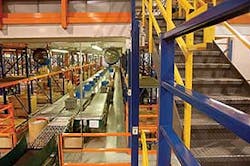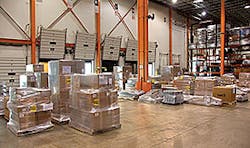Buyers Products PDC “bus route” keeps running rapidly—and very smoothly
WHEN it comes to picking parts from the shelf, things happen quickly at the Buyers Products parts distribution center in Mentor, Ohio—even when filling the order means grabbing parts from all over the warehouse.
“It’s not like we just sell boxes of Cheerios here,” says Gary Kadow, operations manager. “Everyone is asking for something different.”
The company’s PDC handles an average of 1,000 orders a day—typically a wide variety of truck parts and accessories ranging from snowplows to rear observation camera systems. A staff of 70 people is employed at the distribution center, responsible for gathering parts from 23,000 bin locations and shipping the order within 24 hours of receiving it.
Fortunately for the staff, the warehouse is highly automated, with a state-of-the-art computer tracking and picking system.
Like most companies that are involved in the parts business, Buyers PDC generates the majority of its product throughput from a concentrated number of SKUs in its inventory. Recognizing that, the company has concentrated 3,500 of its fastest moving parts along a three-level, serpentine conveyor line. The conveyor snakes its way along all three levels of three separate towers, enabling the company to take full advantage of the building’s 42-ft ceiling height. Eventually a tote filled with parts descends to the ground floor shipping area.
When the company receives an order, a barcode label is generated and attached to a bin or tote that travels the length of the conveyor. Parts are loaded into the tote as it travels past each bin location where the part is stored. When the tote reaches the end of the line, it is emptied and then returned to the beginning of the line to repeat the process. An estimated 4,000 totes make the trip twice a day.
“It’s a lot like running a bus route,” Kadow observes. “We stop and pick up passengers along the way, and it never stops”
The shipping department prepares the contents of the totes for shipping—75% of the time by a parcel service and the remaining 25% by motor carrier.
Forklifts retrieve the parts that are too large to travel via the conveyor system. Although outside the high-volume, three-tiered conveyor system, these larger parts also are efficiently stocked from floor to ceiling. To further maximize available storage space, the racks are separated by aisles that are only six feet wide.
A six-foot-wide aisle allows only four or five inches of clearance for the forklifts and their cargo. To make sure the loads do not drag inventory as the forklifts travel down the aisles, Buyers has installed electronic guide wires along the lengths of the aisles. The floor-mounted sensors guide the vehicles down the center of the aisles. A fleet of 37 tow motors serves the warehouse, picking up items that are too big or bulky to fit into a tote.
The end game
The objective, whether the parts travel by tote or tow motor, is to make it to the shipping department as fast and as accurately as possible.
“It doesn’t matter whether the order is for 50 toolboxes or five pintle hooks,” says Mark Saltzman, President. “The order typically ships within 24 hours.”
That objective is why Buyers Products built the PDC in the first place and expanded it a couple of years ago.
“Ten years ago, it was taking us two weeks to get an order out,” Saltzman said. We wanted to be able to ship within 24 hours.”
The PDC handles 30 LTL trailers and between six and seven full-load trailers daily, via 22 dock doors.
“We control a lot of freight,” Kadow says. Including our sister companies, we operate a fleet of 12 trailers just to bring products from our manufacturing facilities to the PDC.”
Balancing act
Much of what fills the PDC is produced by the company’s own production facilities just down the street.
Because the company manufactures much of what it sells, communication and ordering is more easily controlled. When records show that the PDC has sold and shipped a predefined number of a product, a ticket is automatically generated for the plants to produce a similar number to keep inventories level. Within 48 hours, the stock arrives.
“Toolboxes, pintle hooks, whatever. We maintain about five days of inventory in the warehouse,” Kadow says.
“Our roots are in distribution,” Saltzman says, “but we also are manufacturers. We have to make sure that the plants keep up with demand, and I think we do a good job in that area. If we have 20 items on backorder, that’s a lot for us. That may not seem like many when you are doing 1,000 orders a day, but it’s our job to invest the money we make back into inventory that we can sell to our customers. That’s the key to our success.”
The inventory is becoming increasingly diverse. The company continues to introduce new parts and components. Boomerang Rubber is a recent acquisition that is paying big dividends. A family business that started in the 1950s, Boomerang was sold in the early 2000s. The company went bankrupt, and Buyers was able to buy the assets from the bank.
“We installed new management, rebuilt the facilities, and installed new equipment,” Saltzman says.
Earlier this year, Ford, GM, and Chrysler each signed contracts for Boomerang to supply it with mudflaps, bed mats, and other accessories.
Family owned
Buyers Products, like Boomerang, is a family business based in Ohio. The company started in 1946 selling surplus military truck parts. That sales opportunity eventually ran its course, but laid the foundation for the company to begin contracting with small manufacturers to sell power take-offs, truck body hardware, mudflaps, and other parts. From that point, Buyers expanding reach of products fueled the start-up and acquisition of manufacturing facilities.
While it now markets internationally, Buyers has always called Ohio home. The company has considered operating more than one parts distribution center, but the company believes it can effectively serve North America from its Mentor, Ohio, location.
“We also have some large distributors in the West who redistribute parts for us,” Saltzman says. “But mainly we have a very efficient parts distribution center here in Mentor. With it, we can offer installers and OEMs lower prices to offset the potentially higher freight costs we might experience. It’s a business model that seems to be working.”♦
__________________
Click here to view all large photos and captions
for Buyers Products PDC
About the Author
Bruce Sauer
Editor
Bruce Sauer has been writing about the truck trailer, truck body and truck equipment industries since joining Trailer/Body Builders as an associate editor in 1974. During his career at Trailer/Body Builders, he has served as the magazine's managing editor and executive editor before being named editor of the magazine in 1999. He holds a Bachelor of Journalism degree from the University of Texas at Austin.




